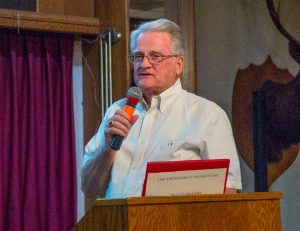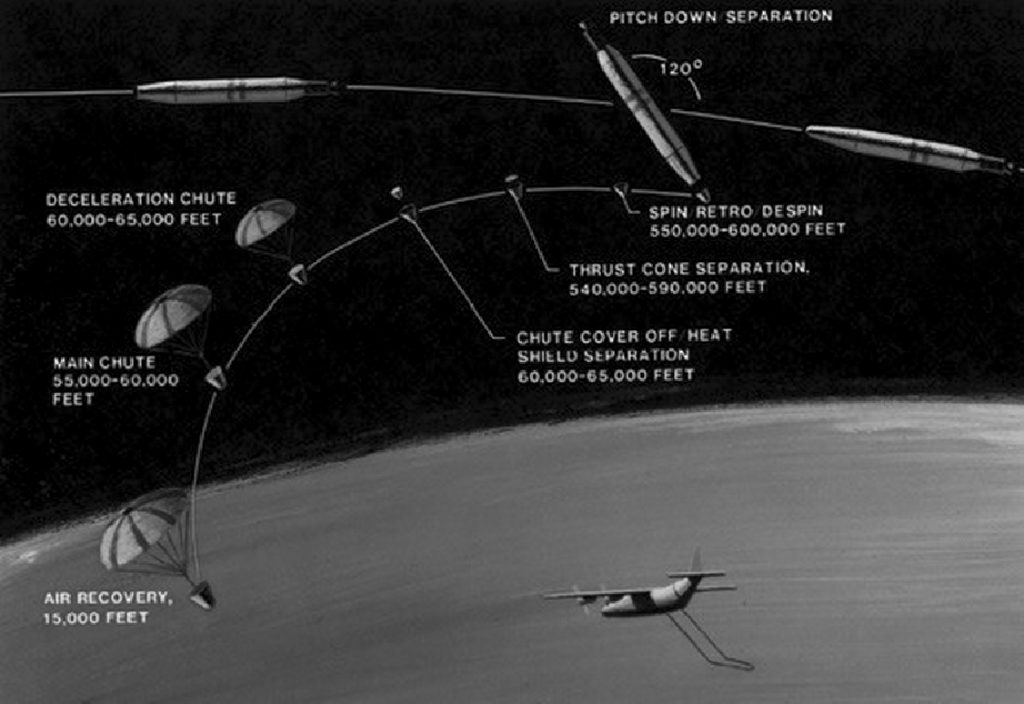 The Grandpa Pettibone Squadron was given a peek into one of the top secret spy gadgets developed during the Cold War. Lieutenant Colonel Leroy Mills (USAF Ret.) told us about his work in developing a satellite spy camera system. The system was so sophisticated that it’s amazing that it could work at all; and, in reality, it worked very well! The concept first developed in 1966 and went through continuous development until 1984 when even more exotic things were developed to replace it. The system’s code word “Gambit” was a rocket launched from Vandenberg Air Force Base. It flew over areas that they wanted to look at and took thousands of pictures on rolls of film 9 ó inches wide and as much as 60 miles long! The film was half the thickness of a sheet of paper. The camera, very much like the Hubbell telescope, could see things on the ground as little as two feet square in great detail. The film would then be put into a container and dropped with a parachute to float back to earth. The Air Force would then intercept the parachute in mid air. An Air Force C-130 with a special hook would be waiting for it to drift down and snag it. Every aspect of this project: the launching, the camera system, the guidance, adjusting the exposure to the film, then dropping it out and having a plane catch it is really in the science fiction category, but it really happened. In fact, it happened dozens of times.
The Grandpa Pettibone Squadron was given a peek into one of the top secret spy gadgets developed during the Cold War. Lieutenant Colonel Leroy Mills (USAF Ret.) told us about his work in developing a satellite spy camera system. The system was so sophisticated that it’s amazing that it could work at all; and, in reality, it worked very well! The concept first developed in 1966 and went through continuous development until 1984 when even more exotic things were developed to replace it. The system’s code word “Gambit” was a rocket launched from Vandenberg Air Force Base. It flew over areas that they wanted to look at and took thousands of pictures on rolls of film 9 ó inches wide and as much as 60 miles long! The film was half the thickness of a sheet of paper. The camera, very much like the Hubbell telescope, could see things on the ground as little as two feet square in great detail. The film would then be put into a container and dropped with a parachute to float back to earth. The Air Force would then intercept the parachute in mid air. An Air Force C-130 with a special hook would be waiting for it to drift down and snag it. Every aspect of this project: the launching, the camera system, the guidance, adjusting the exposure to the film, then dropping it out and having a plane catch it is really in the science fiction category, but it really happened. In fact, it happened dozens of times.
 One of the cameras is on display at the National Air and Space Museum at Dulles Airport. It is gigantic! It’s as big as a school bus. It is more than 50 feet long and weighs 25,000 to 30,000 pounds. This project was super secret until 2011, 25 years after the last Cold War mission. The coordination and required secrecy to put dozens of secret projects that made up the “Gambit” vehicle is amazing. From the Lockheed Agina Rocket that launched it to the optical camera developed years before the Hubbell telescope to the special super high, super thin roll film developed by Kodak to the various control systems to make it all work remotely from the ground and then drop the film and actually catch it would make a cliff hangar Star Wars movie. It had to take several thousand engineers, scientists and other specialists—all working secretly—to put this together. I have personally talked to one of the pilots that flew the C- 130 to catch the film package. He said he did seven or eight catches. The parachute with the film always showed up at the time and place where he was told it would. This in itself is remarkable, and the pilot’s skill in catching it is equally remarkable!
One of the cameras is on display at the National Air and Space Museum at Dulles Airport. It is gigantic! It’s as big as a school bus. It is more than 50 feet long and weighs 25,000 to 30,000 pounds. This project was super secret until 2011, 25 years after the last Cold War mission. The coordination and required secrecy to put dozens of secret projects that made up the “Gambit” vehicle is amazing. From the Lockheed Agina Rocket that launched it to the optical camera developed years before the Hubbell telescope to the special super high, super thin roll film developed by Kodak to the various control systems to make it all work remotely from the ground and then drop the film and actually catch it would make a cliff hangar Star Wars movie. It had to take several thousand engineers, scientists and other specialists—all working secretly—to put this together. I have personally talked to one of the pilots that flew the C- 130 to catch the film package. He said he did seven or eight catches. The parachute with the film always showed up at the time and place where he was told it would. This in itself is remarkable, and the pilot’s skill in catching it is equally remarkable!
The system was obviously very successful as the Air Force continued improving it with later models. Lieutenant Colonel Mills was hands-on in Star War level projects during most of his military service working with various special secret projects. It is a real honor to have him as our guest.




